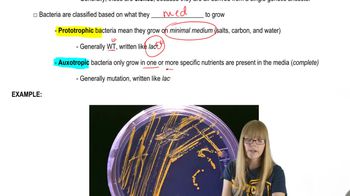How do we know that bacteria undergo genetic recombination, allowing the transfer of genes from one organism to another?
Table of contents
- 1. Introduction to Genetics51m
- 2. Mendel's Laws of Inheritance3h 37m
- 3. Extensions to Mendelian Inheritance2h 41m
- 4. Genetic Mapping and Linkage2h 28m
- 5. Genetics of Bacteria and Viruses1h 21m
- 6. Chromosomal Variation1h 48m
- 7. DNA and Chromosome Structure56m
- 8. DNA Replication1h 10m
- 9. Mitosis and Meiosis1h 34m
- 10. Transcription1h 0m
- 11. Translation58m
- 12. Gene Regulation in Prokaryotes1h 19m
- 13. Gene Regulation in Eukaryotes44m
- 14. Genetic Control of Development44m
- 15. Genomes and Genomics1h 50m
- 16. Transposable Elements47m
- 17. Mutation, Repair, and Recombination1h 6m
- 18. Molecular Genetic Tools19m
- 19. Cancer Genetics29m
- 20. Quantitative Genetics1h 26m
- 21. Population Genetics50m
- 22. Evolutionary Genetics29m
5. Genetics of Bacteria and Viruses
Working with Microorganisms
Problem 4a
Textbook Question
Fifteen bacterial colonies growing on a complete medium are transferred to a minimal medium. Twelve of the colonies grow on minimal medium.
Using terminology, characterize the 12 colonies that grow on minimal medium and the 3 colonies that do not.
 Verified step by step guidance
Verified step by step guidance1
Identify the type of medium used: A complete medium contains all the nutrients required for bacterial growth, while a minimal medium contains only the essential nutrients that the bacteria must synthesize themselves.
Characterize the 12 colonies that grow on minimal medium: These colonies are considered prototrophs, meaning they can synthesize all the compounds they need for growth from the minimal medium's basic nutrients.
Characterize the 3 colonies that do not grow on minimal medium: These colonies are considered auxotrophs, meaning they have mutations that prevent them from synthesizing one or more essential compounds, which must be provided externally for their growth.
Explain the genetic basis: The auxotrophic colonies likely have mutations in genes responsible for the biosynthesis of specific nutrients, such as amino acids, nucleotides, or vitamins, which are absent in the minimal medium.
Summarize the distinction: Prototrophs are wild-type bacteria capable of growing on minimal medium, while auxotrophs are mutants that require supplementation of specific nutrients to grow.
 Verified video answer for a similar problem:
Verified video answer for a similar problem:This video solution was recommended by our tutors as helpful for the problem above
Video duration:
2mPlay a video:
Was this helpful?
Key Concepts
Here are the essential concepts you must grasp in order to answer the question correctly.
Complete Medium vs. Minimal Medium
Complete medium contains all the nutrients necessary for bacterial growth, including amino acids, vitamins, and other growth factors. In contrast, minimal medium provides only the essential nutrients required for growth, typically a carbon source, nitrogen, salts, and water. Understanding the difference between these media is crucial for characterizing bacterial colonies based on their nutritional requirements.
Recommended video:
Guided course

Conjugation Overview
Auxotrophs and Prototrophs
Prototrophs are bacteria that can synthesize all the compounds they need for growth from minimal medium, while auxotrophs lack the ability to synthesize one or more essential compounds and require additional nutrients found in complete medium. In this context, the 12 colonies that grow on minimal medium are likely prototrophs, whereas the 3 colonies that do not grow are auxotrophs, indicating their specific nutrient deficiencies.
Recommended video:
Guided course

Bacteria in the Laboratory
Selection Pressure
Selection pressure refers to environmental factors that favor certain traits over others, influencing the survival and reproduction of organisms. In this scenario, transferring colonies from complete to minimal medium creates a selection pressure that favors prototrophic bacteria capable of surviving on limited nutrients, while auxotrophic colonies are unable to thrive, highlighting the importance of nutrient availability in microbial growth.
Recommended video:
Guided course

Natural Selection

 9:35m
9:35mWatch next
Master Bacteria in the Laboratory with a bite sized video explanation from Kylia
Start learningRelated Videos
Related Practice
Textbook Question
320
views
